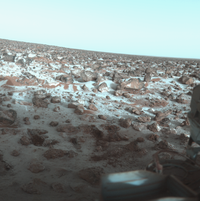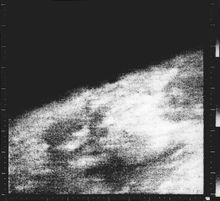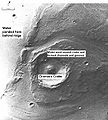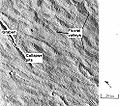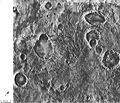- Exploration of Mars
-
Viking Lander 2 site May 1979Viking Lander 1 site February 1978
The exploration of Mars has been an important part of the space exploration programs of the Soviet Union, the United States, Europe, and Japan. Dozens of robotic spacecraft, including orbiters, landers, and rovers, have been launched toward Mars since the 1960s. These missions were aimed at gathering data about current conditions and answering questions about the history of Mars as well as a preparation for a possible human mission to Mars. The questions raised by the scientific community are expected to not only give a better appreciation of the red planet but also yield further insight into the past, and possible future, of Earth.
The exploration of Mars has come at a considerable financial cost with roughly two-thirds of all spacecraft destined for Mars failing before completing their missions, with some failing before they even begin. Such a high failure rate can be attributed to the complexity and large number of variables involved in an interplanetary journey, and has led researchers to jokingly speak of The Great Galactic Ghoul [1] which subsists on a diet of Mars probes. This phenomenon is also informally known as the Mars Curse.[2] As of July 2011, there is one functioning piece of equipment on the surface of Mars beaming signals back to Earth: the Opportunity rover.
In October 2009, an agreement was signed between United States' space agency, NASA, and Europe's space agency, ESA in order to increase cooperation and expand collective capabilities, resources and expertise to continue the exploration of Mars; this agreement is named the Mars Exploration Joint Initiative (MEJI).[3][4]
Contents
The planet Mars
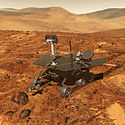 Computer-generated image of Spirit Mars Exploration Rover which touched down in Gusev Crater in 2004.
Computer-generated image of Spirit Mars Exploration Rover which touched down in Gusev Crater in 2004.
 Real image from Mars, part of a panorama taken by the Spirit rover in 2004
Real image from Mars, part of a panorama taken by the Spirit rover in 2004 Main article: Mars
Main article: MarsMars has long been the subject of human fascination. Early telescopic observations revealed color changes on the surface which were originally attributed to seasonal vegetation as well as apparent linear features which were ascribed to intelligent design. These early and erroneous interpretations led to widespread public interest in Mars. Further telescopic observations found Mars' two moons - Phobos and Deimos, the polar ice caps and the feature now known as Olympus Mons, the solar system's tallest mountain.[5] These discoveries piqued further interest in the study and exploration of the red planet. Mars is a rocky planet, like Earth, that formed around the same time, yet with only half the diameter of Earth, and a far thinner atmosphere, it has a cold and desert-like surface. It is notable, however, that although the planet has only one quarter of the surface area of the Earth, it has about the same land area, since only one quarter of the surface area of the Earth is land.
Launch windows
In order to understand the history of the robotic exploration of Mars it is important to note that minimum-energy launch windows occur at intervals of approximately 2.135 years, i.e. 780 days (the planet's synodic period with respect to Earth). This is a consequence of the Hohmann transfer orbit for minimum-energy interplanetary transfer. The slight inclination and eccentricity of Mars' orbit relative to Earth's orbit means that the minimum energy launch date differs from that implied by the synodic period slightly. Launch window width is subject to vehicle constraints but are typically on the order of one month wide. The windows for recent/future years were/will be centred on the following dates:[citation needed]
- 18 November 1996 (MJD 50405)
- 22 January 1999 (MJD 51200)
- 19 April 2001 (MJD 52018)
- 5 June 2003 (MJD 52795)
- 10 August 2005 (MJD 53592)
- 21 September 2007 (MJD 54364)
- 15 October 2009 (MJD 55119)
- 7 November 2011 (MJD 55872)
- 2 January 2014 (MJD 56659)
Minimum energy inbound (Mars to Earth) launch windows also occur at similar intervals.[citation needed]
In addition to these minimum-energy trajectories, which occur when the planets are aligned so that the Earth to Mars transfer trajectory goes halfway around the Sun, an alternate trajectory which has been proposed goes first inward toward Venus orbit, and then outward, resulting in a longer trajectory which goes about 360 degrees around the Sun [6][Full citation needed].
Early flyby probes and orbiters
Early Soviet missions
Main article: Mars 1MMain article: Mars 1The Mars 1M program (sometimes dubbed Marsnik in Western media) was the first Soviet unmanned spacecraft interplanetary exploration program, which consisted of two flyby probes launched towards Mars in October 1960, Mars 1960A and Mars 1960B (also known as Korabl 4 and Korabl 5 respectively). After launch, the third stage pumps on both launchers were unable to develop enough thrust to commence ignition, so Earth parking orbit was not achieved. The spacecraft reached an altitude of 120 km before reentry.
Mars 1962A was a Mars fly-by mission, launched on October 24, 1962 and Mars 1962B a lander mission, launched in late December of the same year both failed from either breaking up as they were going into Earth orbit or having the upper stage explode in orbit during the burn to put the spacecraft into the Mars trajectory.
Mars 1 (1962 Beta Nu 1) an automatic interplanetary station launched to Mars on November 1, 1962 was the first probe of the Soviet Mars probe program. Mars 1 was intended to fly by the planet at a distance of about 11,000 km and take images of the surface as well as send back data on cosmic radiation, micrometeoroid impacts and Mars' magnetic field, radiation environment, atmospheric structure, and possible organic compounds. Sixty-one radio transmissions were held, initially at two day intervals and later at 5 days in which a large amount of interplanetary data was collected. On 21 March 1963, when the spacecraft was at a distance of 106,760,000 km from Earth, on its way to Mars, communications ceased, due to failure of the spacecraft's antenna orientation system.
In 1964, both Soviet probe launches, of Zond 1964A on June 4, and Zond 2 on November 30, (part of the Zond program), resulted in failures. Zond 1964A had a failure at launch, while communication was lost with Zond 2 en route to Mars after a mid-course maneuver, in early May 1965.
The USSR intended to have the first artificial satellite of Mars beating the planned American Mariner 8 and Mariner 9 martian orbiters. But on May 5, 1971 Cosmos 419 (Mars 1971C), a heavy probe of the Soviet Mars program M-71, failed on launch. This spacecraft was designed as an orbiter only, while the second and third probes of project M-71, Mars 2 and Mars 3, were multi-aimed combinations of orbiter and lander.
Mariner program
Main article: Mariner program Mariner Crater, as seen by Mariner 4. The location is Phaethontis quadrangle.
Mariner Crater, as seen by Mariner 4. The location is Phaethontis quadrangle.
In 1964, NASA's Jet Propulsion Laboratory made two attempts at reaching Mars. Mariner 3 and Mariner 4 were identical spacecraft designed to carry out the first flybys of Mars. Mariner 3 was launched on November 5, 1964, but the shroud encasing the spacecraft atop its rocket failed to open properly, and it failed to reach Mars. Three weeks later, on November 28, 1964, Mariner 4 was launched successfully on a 7½-month voyage to the red planet.
Mariner 4 flew past Mars on July 14, 1965, providing the first close-up photographs of another planet. The pictures, gradually played back to Earth from a small tape recorder on the probe, showed lunar-type impact craters.
NASA continued the Mariner program with another pair of Mars flyby probes, Mariner 6 and 7, at the next launch window. These probes reached the planet in 1969. During the following launch window the Mariner program again suffered the loss of one of a pair of probes. Mariner 9 successfully entered orbit about Mars, the first spacecraft ever to do so, after the launch time failure of its sister ship, Mariner 8. When Mariner 9 reached Mars, it and two Soviet orbiters (Mars 2 and Mars 3, see Mars probe program below) found that a planet-wide dust storm was in progress. The mission controllers used the time spent waiting for the storm to clear to have the probe rendezvous with, and photograph, Phobos. When the storm cleared sufficiently for Mars' surface to be photographed by Mariner 9, the pictures returned represented a substantial advance over previous missions. These pictures were the first to offer evidence that liquid water might at one time have flowed on the planetary surface.
Viking program
The Viking Orbiters caused a revolution in our ideas about water on Mars. Huge river valleys were found in many areas. They showed that floods of water carved deep valleys, eroded grooves into bedrock, and traveled thousands of kilometers. Areas of branched streams, in the southern hemisphere, suggested that rain once fell.[7][8][9]
The images below, some of the best from the Viking Orbiters, are mosaics of many small, high resolution images. Click on the images for more detail. Some of the pictures are labeled with place names.
-
Tear-drop shaped islands caused by flood waters from Maja Valles, as seen by Viking Orbiter. Image is located in Oxia Palus quadrangle. The islands are formed in the ejecta of Lod Crater, Bok Crater, and Gold Crater.
-
Waters from Vedra Vallis, Maumee Vallis, and Maja Vallis went from Lunae Planum on the left, to Chryse Planitia on the right. Image is located in Lunae Palus quadrangle and was taken by Viking Orbiter.
-
Area around Northern Kasei Valles, showing relationships among Kasei Valles, Bahram Vallis, Vedra Vallis, Maumee Vallis, and Maja Valles. Map location is in Lunae Palus quadrangle and includes parts of Lunae Planum and Chryse Planitia.
-
The ejecta from Arandas Crater acts like mud. It moves around small craters (indicated by arrows), instead of just falling down on them. Craters like this suggest that large amounts of frozen water were melted when the impact crater was produced. Image is located in Mare Acidalium quadrangle and was taken by Viking Orbiter.
-
This view of the flank of Alba Patera shows several channels/troughs. Some channels are associated with lava flows; others are probably caused by running water. A large trough or graben turns into a line of collapse pits. Image is located in Arcadia quadrangle and was taken by Viking Orbiter.
-
The branched channels seen by Viking from orbit strongly suggested that it rained on Mars in the past. Image is located in Margaritifer Sinus quadrangle.
-
Ravi Vallis, as seen by Viking Orbiter. Ravi Vallis was probably formed when catastrophic floods came out of the ground to the right (chaotic terrain). Image located in Margaritifer Sinus quadrangle.
Surface missions
Main article: Mars landingThe following is a map of landings on Mars.

The Soviet Union intended to beat the USA by sending landers first in the Mars probe program M-69 in 1969, but both probes of the new heavy 5-ton design, Mars 1969A and Mars 1969B, failed at launch.
The first probes to impact and land on Mars were the Soviet Union's Mars 2 and Mars 3, as part of the Mars probe program M-71 in 1971. Each carried a lander. The Mars 2 lander crashed; Mars 3 was the first successful lander but stopped transmitting data and images from the surface after 15 seconds of operation.
Mars 6 and Mars 7 landers on the next Soviet Mars probe program M-73 failed their missions in 1974; the first impacted on the surface, while the second missed the planet.
The first landers to successfully accomplish their missions were the American Viking 1 and Viking 2 in 1976.
Mars Curse
The high failure rate of missions launched from Earth attempting to explore Mars has become informally known as the "Mars Curse" or "Martian Curse". The "Galactic Ghoul"[10] or "Great Galactic Ghoul" is a fictional space monster jokingly said to consume Mars probes, a term coined in 1997 by Time Magazine journalist Donald Neff.[11][12][13]
Of 38 launches from Earth in an attempt to reach the planet, only 19 succeeded, a success rate of 50%. Twelve of the missions included attempts to land on the surface, but only seven transmitted data after landing.
The majority of the failed missions occurred in the early years of space exploration and were part of the Soviet and later Russian Mars probe program that suffered several technical difficulties, other than the largely successful Venera program for the exploration of Venus.
Modern missions have an improved success rate; however, the challenge, complexity and length of the missions make it inevitable that failures will occur.[14]
The U.S. NASA Mars exploration program has had a somewhat better record of success in Mars exploration, achieving success in 13 out of 20 missions launched (a 65% success rate), and succeeding in six out of seven (an 86% success rate) lander missions.
Failed and cancelled Mars missions Failed at launch 
Failed en route Mars 1 · Zond 2 · Mars 6 · Mars 7 · Phobos 1 · Mars Observer · Nozomi · Mars Climate Orbiter · Mars Polar Lander · Deep Space 2 · Beagle 2Cancelled (year cancelled) Voyager · Marsokhod (Mars 4NM) · Mars sample return (Mars 5NM) · Mars Surveyor 2001 Lander · NetLander · Mars Telecommunications Orbiter · Beagle 3 · Mars Astrobiology Explorer-Cacher (2011)Manned missions
Main article: Manned mission to MarsMany people have long advocated a manned mission to Mars as the next logical step for a manned space program after lunar exploration. Aside from the prestige such a mission would bring, advocates argue that humans would easily be able to outperform robotic explorers, justifying the expense. Aerospace engineer Bob Zubrin is one of the main proponents of such missions. Some critics contend, however, that robots can perform better than humans at a fraction of the expense. If life exists on Mars, a manned mission could contaminate it by introducing earthly microbes, so robotic exploration would be preferable.[15] A list of hypothetical or proposed manned Mars missions is located at manned mission to Mars.
Timeline of Mars exploration
mission type success rate success partial success launch failure failed in route failed to orbit/land flyby 45% 5 4 2 orbiter 50% 9 2 5 3 3 lander 30% 3 3 4 rover 80% 3 1 1 sample return 0% 1 total 47% 20 3 9 9 8 Mission (1960–1969) Launch Arrival at Mars Termination Elements Result  Mars 1960A
Mars 1960A10 October 1960 10 October 1960 Flyby Launch failure  Mars 1960B
Mars 1960B14 October 1960 14 October 1960 Flyby Launch failure  Sputnik 22 (Mars 1962A)
Sputnik 22 (Mars 1962A)24 October 1962 24 October 1962 Flyby Broke up shortly after launch  Mars 1
Mars 11 November 1962 21 March 1963 Flyby Some data collected, but lost contact before reaching Mars, flyby at approx. 193,000 km  Sputnik 24 (Mars 1962B)
Sputnik 24 (Mars 1962B)4 November 1962 19 January 1963 Lander Failed to leave Earth's orbit  Mariner 3
Mariner 35 November 1964 5 November 1964 Flyby Failure during launch ruined trajectory  Mariner 4
Mariner 428 November 1964 14 July 1965 21 December 1967 Flyby Success (first successful flyby)  Zond 2
Zond 230 November 1964 May 1965 Flyby Communication lost three months before reaching Mars  Mariner 6
Mariner 625 February 1969 31 July 1969 August 1969 Flyby Success  Mariner 7
Mariner 727 March 1969 5 August 1969 August 1969 Flyby Success  Mars 1969A
Mars 1969A27 March 1969 27 March 1969 Orbiter Launch failure  Mars 1969B
Mars 1969B2 April 1969 2 April 1969 Orbiter Launch failure Mission (1970–1989) Launch Arrival at Mars Termination Elements Result  Mariner 8
Mariner 88 May 1971 8 May 1971 Orbiter Launch failure  Cosmos 419 (Mars 1971C)
Cosmos 419 (Mars 1971C)10 May 1971 12 May 1971 Orbiter Launch failure  Mariner 9
Mariner 930 May 1971 13 November 1971 27 October 1972 Orbiter Success (first successful orbit)  Mars 2
Mars 219 May 1971 27 November 1971 22 August 1972 Orbiter Success 27 November 1971 Lander, rover[16] Crashed on surface of Mars  Mars 3
Mars 328 May 1971 2 December 1971 22 August 1972 Orbiter Success 2 December 1971 Lander, rover[16] Partial success. First successful landing; landed softly but ceased transmission within 15 seconds  Mars 4
Mars 421 July 1973 10 February 1974 10 February 1974 Orbiter Could not enter orbit, made a close flyby  Mars 5
Mars 525 July 1973 2 February 1974 21 February 1974 Orbiter Partial success. Entered orbit and returned data, but failed within 9 days  Mars 6
Mars 65 August 1973 12 March 1974 12 March 1974 Lander Partial success. Data returned during descent but not after landing on Mars  Mars 7
Mars 79 August 1973 9 March 1974 9 March 1974 Lander Landing probe separated prematurely; entered heliocentric orbit  Viking 1
Viking 120 August 1975 20 July 1976 17 August 1980 Orbiter Success 13 November 1982 Lander Success  Viking 2
Viking 29 September 1975 3 September 1976 25 July 1978 Orbiter Success 11 April 1980 Lander Success  Phobos 1
Phobos 17 July 1988 2 September 1988 Orbiter Contact lost while on route to Mars Lander Not deployed  Phobos 2
Phobos 212 July 1988 29 January 1989 27 March 1989 Orbiter Partial success: entered orbit and returned some data. Contact lost just before deployment of landers Landers Not deployed Mission (1990–1999) Launch Arrival at Mars Termination Elements Result  Mars Observer
Mars Observer25 September 1992 24 August 1993 21 August 1993 Orbiter Lost contact just before arrival  Mars Global Surveyor
Mars Global Surveyor7 November 1996 11 September 1997 5 November 2006 Orbiter Success  Mars 96
Mars 9616 November 1996 17 November 1996 Orbiter, lander, penetrator Launch failure  Mars Pathfinder
Mars Pathfinder4 December 1996 4 July 1997 27 September 1997 Lander, rover Success  Nozomi (Planet-B)
Nozomi (Planet-B)3 July 1998 9 December 2003 Orbiter Complications while on route; Never entered orbit  Mars Climate Orbiter
Mars Climate Orbiter11 December 1998 23 September 1999 23 September 1999 Orbiter Crashed on surface due to metric-imperial mix-up  Mars Polar Lander
Mars Polar Lander3 January 1999 3 December 1999 3 December 1999 Lander Crash-landed on surface due to improper hardware testing  Deep Space 2 (DS2)
Deep Space 2 (DS2)Hard landers Mission (2000–2011+) Launch Arrival at Mars Termination Elements Result  2001 Mars Odyssey
2001 Mars Odyssey7 April 2001 24 October 2001 Currently operational Orbiter Success  Mars Express
Mars Express2 June 2003 25 December 2003 Currently operational Orbiter Success  Beagle 2
Beagle 26 February 2004 Lander Lost contact in December 2003 after separation from Mars Express. Fate unknown.  MER-A Spirit
MER-A Spirit10 June 2003 4 January 2004 last contact March 2010, stuck. Contact lost. Rover Success  MER-B Opportunity
MER-B Opportunity7 July 2003 25 January 2004 Currently operational Rover Success  Rosetta
Rosetta2 March 2004 February 25, 2007 Currently operational Gravity assist enroute to comet 67P/Churyumov-Gerasimenko Success  Mars Reconnaissance Orbiter
Mars Reconnaissance Orbiter12 August 2005 10 March 2006 Currently operational Orbiter Success  Phoenix
Phoenix4 August 2007 25 May 2008 10 November 2008 Lander Success  Dawn
Dawn27 September 2007 17 February 2009 Currently operational Gravity assist to Vesta Success  Fobos-Grunt
Fobos-Grunt8 November 2011 September 2012 Currently operational Orbiter Launch complications[17]  Yinghuo-1
Yinghuo-1October 2012 Orbiter Launch complications[18] Future missions
Name Estimated launch Elements Notes  MSL Curiosity
MSL CuriosityBetween 25 November and 18 December 2011[19] Rover Powered by radioisotopes, it will perform chemical and physical analysis on martian soil and atmosphere.  MetNet
MetNet2012–2019 Multi-lander network Simultaneous meteorological measurements at multiple locations.[20]  MAVEN
MAVEN2013 Orbiter Will study Mars' upper atmosphere 
ExoMars2016 Orbiter, static lander The Trace Gas Orbiter will deliver the ExoMars static lander. 2018 Rover ExoMars rover  Mars mission
Mars mission2013-2015[21] Orbiter In the conceptual phase[22][23] 
Mars sample return mission2020s Orbiter, lander, rover, sample return Under study; not yet funded or scheduled Concept missions
There are a number of conceptual missions for the exploration of Mars, but the missions are not yet fully funded nor under development.
- 'Red Dragon' Mars Mission
As of July 2011[update], NASA Ames Research Center is developing a concept for a low-cost Mars mission that would utilize a SpaceX Falcon Heavy as the launch vehicle and trans-Martian injection vehicle, and the Dragon capsule to enter the Martian atmosphere. The concept would be proposed for funding in 2012/2013 as a NASA Discovery mission, for launch in 2018 and arrival at Mars several months later. The science objectives of the mission would be to look for evidence of life — detecting "molecules that are proof of life, like DNA or perchlorate reductase ... proof of life through biomolecules. ... Red Dragon would drill 3.3 feet (1.0 m) or so underground, in an effort to sample reservoirs of water ice known to lurk under the red dirt." The mission cost is projected to be less than US$425,000,000, not including the launch cost.[24]
Cancelled missions
- Mars 4NM and Mars 5NM - projects intended by the Soviet Union for heavy Marsokhod (in 1973 according to initial plan of 1970) and Mars sample return (planned for 1975) missions by launching on N1 rocket that has never flown successfully.[25]
- Voyager - USA, 1970s - Two orbiters and two landers, launched by a single Saturn V rocket.
- Mars Aerostat - Russian/French balloon mission,[26] originally planned for the 1992 launch window, postponed to 1994 and then to 1996 before being cancelled.[27]
- Mars Environmental Survey - set of 16 landers planned for 1999–2009
- Mars-98 - Russian mission including an orbiter, lander, and rover, planned for 1998 launch opportunity
- Mars Surveyor 2001 Lander - October 2001 - Mars lander
- Beagle 3 - 2009 British lander mission meant to search for life, past or present.
- NetLander- 2007 or 2009 - Mars netlanders
- Mars Telecommunications Orbiter - September 2009 - Mars orbiter for telecommunications
- Mars Astrobiology Explorer-Cacher - 2018 rover
- Kitty Hawk - Mars airplane micromission, proposed for December 17, 2003, the centennial of the Wright brother's first flight.[28] Its funding was eventually given to the 2003 Mars Network project.[29]
See also
- Atmospheric reentry
- Life on Mars
- List of artificial objects on Mars
- Mars Exploration Joint Initiative
- Mars Scout Program
- Mars to Stay
- New Frontiers Program
- Space colonization
- Space exploration
- Space weather
- Timeline of Solar System exploration
- Jet Propulsion Laboratory Science Division
References
- ^ Dinerman, Taylor (2004-09-27). "Is the Great Galactic Ghoul losing his appetite?". The space review. http://www.thespacereview.com/article/232/1. Retrieved 2007-03-27.
- ^ Knight, Matthew. "Beating the curse of Mars". Science & Space. http://www.cnn.com/2006/TECH/science/12/23/mwonders.mars/index.html. Retrieved 2007-03-27.
- ^ "NASA and ESA Establish a Mars Exploration Joint Initiative". NASA. July 8, 2009. http://www.nasa.gov/mission_pages/mars/news/mars-20090708.html. Retrieved 2009-11-09.
- ^ "NASA, ESA Set Up Mars Exploration Framework". Aviation Week. July 10, 2009. http://www.aviationweek.com/aw/generic/story_channel.jsp?channel=space&id=news/Mars071009.xml. Retrieved 2009-11-09.
- ^ Sheehan, William (1996). "The Planet Mars: A History of Observation and Discovery". The University of Arizona Press, Tucson. http://www.uapress.arizona.edu/onlinebks/mars/contents.htm. Retrieved 2009-02-15.
- ^ ("opposition-class trajectory")
- ^ ISBN 0-8165-1257-4
- ^ Raeburn, P. 1998. Uncovering the Secrets of the Red Planet Mars. National Geographic Society. Washington D.C.
- ^ Moore, P. et al. 1990. The Atlas of the Solar System. Mitchell Beazley Publishers NY, NY.
- ^ Bothwell, William (2008-10-23). "Looking to Mars". Orangeville Citizen. http://www.citizen.on.ca/news/2008/1023/columns/032.html. Retrieved 2008-10-29.
- ^ "The Depths of Space: The Story of the Pioneer Planetary Probes (2004)" from The National Academies Press. URL accessed April 7, 2006.
- ^ "Uncovering the Secrets of Mars" (first paragraph only). Time July 14, 1997 Vol. 150 No. 2. URL accessed April 7, 2006.
- ^ Matthews, John & Caitlin. "The Element Encyclopedia of Magical Creatures",Barnes & Noble Publishing, 2005. ISBN 0-7607-7885-X
- ^ The "Mars Curse": Why Have So Many Missions Failed?
- ^ Lupisella, ML. "Human Mars Mission Contamination Issues." NASA.
- ^ a b "The First Rover on Mars - The Soviets Did It in 1971" The Planetary Report July/August 1990 issue. URL accessed March 30, 2006.
- ^ http://www.msnbc.msn.com/id/45208128/ns/technology_and_science-space/
- ^ http://www.msnbc.msn.com/id/45208128/ns/technology_and_science-space/
- ^ "Geometry Drives Selection Date for 2011 Mars Launch". News and Features. NASA/JPL-Caltech. http://www.jpl.nasa.gov/news/news.cfm?release=2010-171.
- ^ MetNet Mars Mission
- ^ http://articles.timesofindia.indiatimes.com/2009-08-31/india/28164136_1_chandrayaan-1-indian-deep-space-network-first-moon-mission
- ^ "ISRO gearing up for Mars mission news". Aviation and Aerospace. August 12, 2009. http://www.domain-b.com/aero/space/spacemissions/20090812_chandrayaan_1_oneView.html. Retrieved 2009-08-20.
- ^ "ISRO Eyes Mission To Mars As Government Sanctions Funding". Mars Daily. August 13, 2009. http://www.marsdaily.com/reports/ISRO_Eyes_Mission_To_Mars_As_Government_Sanctions_Funding_999.html. Retrieved 2009-08-20.
- ^ Wall, Mike (2011-07-31). "'Red Dragon' Mission Mulled as Cheap Search for Mars Life". SPACE.com. http://www.space.com/12489-nasa-mars-life-private-spaceship-red-dragon.html. Retrieved 2011-07-31. "This so-called "Red Dragon" mission, which could be ready to launch by 2018, would carry a cost of about $400 million or less. ... developing the Red Dragon concept as a potential NASA Discovery mission, a category that stresses exploration on the relative cheap. ... NASA will make another call for Discovery proposals in 18 months or so... If Red Dragon is selected in that round, it could launch toward Mars in 2018. ... Assuming that $425 million cap [for NASA Discovery missions] is still in place, Red Dragon could come in significantly under the bar. We'd have money left over to do some science."
- ^ Советский грунт с Марса (Russian)
- ^ C. Tarrieu, "Status of the Mars 96 Aerostat Development", Paper IAF-93-Q.3.399, 44th Congress of the International Astronautical Federation, 1993.
- ^ P.B. de Selding, "Planned French Balloon May Be Dropped", Space News, 17–23 April 1995, pp. 1, 20
- ^ Oliver Morton in To Mars, En Masse, p.1103-04, Science (Magazine) vol 283, 19 february 1999, ISSN 0036-8075
- ^ MIT Mars Airplane Project
Further reading
- Mars - A Warmer, Wetter Planet by Jeffrey S. Kargel (published July 2004; ISBN 978-1-85233-568-7)
- The Compact NASA Atlas of the Solar System by Ronald Greeley and Raymond Batson (published January 2002; ISBN 0-5218-0633-X)
- Mars: The NASA Mission Reports / edited by Robert Godwin (2000) ISBN 1896522629
External links
- Mars Program by the American JPL
- Mars Rovers' newsroom
- Next on Mars (Bruce Moomaw, Space Daily, 9 March 2005): An extensive overview of NASA's Mars exploration plans
- Catalog of Soviet Mars images Collection of Russian Mars probes' images.
- Mars balloon
- NASA History Series Publications (many of which are on-line)
- Simplified study of orbits to land on Mars and return to Earth High School level.
Exploration of the Solar System Exploration of other planets: Exploration of the Moon · Exploration of Mercury · Exploration of Venus · Exploration of Mars · Exploration of Jupiter · Exploration of Saturn · Exploration of Uranus · Exploration of NeptuneLists: Objects on other planets Spacecraft missions to Mars Flybys 
Orbiters Mariner 9 · Mars 2 · 3 · 5 · Viking 1 · 2 · Phobos 2 · Mars Global Surveyor · 2001 Mars Odyssey · Mars Express · Mars Reconnaissance Orbiter · Fobos-Grunt · Yinghuo-1
Landers Rovers Planned missions Mars Science Laboratory (2011) · MetNet · MAVEN (2013) ·
ExoMars static lander and rover · ExoMars Trace Gas Orbiter (2016) · Northern LightUnplanned missions Related topics Exploration · Colonization · Failed Mars missions · Mars Scout Program
Bold italics indicate active missionsFailed and cancelled Mars missions Failed at launch 
Failed en route Mars 1 · Zond 2 · Mars 6 · Mars 7 · Phobos 1 · Mars Observer · Nozomi · Mars Climate Orbiter · Mars Polar Lander · Deep Space 2 · Beagle 2Cancelled (year cancelled) Voyager · Marsokhod (Mars 4NM) · Mars sample return (Mars 5NM) · Mars Surveyor 2001 Lander · NetLander · Mars Telecommunications Orbiter · Beagle 3 · Mars Astrobiology Explorer-Cacher (2011)Mars Areography General- Observation history
- Albedo features (Solis Lacus)
- Atmosphere
- Canals (list)
- Climate
- Color
- Water
- Glaciers
- Life
- North Polar Basin
- Chaos terrain
- Noachian
- Soil
Regions- Alba Mons
- Albor Tholus
- Arsia Mons
- Ascraeus Mons
- Biblis Tholus
- Elysium Mons
- Hecates Tholus
- Olympus Mons
- Pavonis Mons
- Syrtis Major Planum
- Tharsis
- Tharsis Montes
- North Polar Basin
- Hellas Planitia
- Argyre Planitia
- Schiaparelli
- Gusev
- Eberswalde
- Bonneville
- Eagle
- Endeavour
- Endurance
- Erebus
- Victoria
- Gale
- Galle
- Ibragimov
- Santa Maria
- Valles
- Chasmata
- Outflow channel
- Valles Marineris
Moons Specific- Phobos
- (Features
- Stickney crater
- Monolith)
- Deimos
- (Features)
CommonExploration Past and
CurrentFutureAstronomy EclipsesAsteroidsMeteorites Other topics - Darian calendar
- Timekeeping on Mars
- Flag of Mars
- In Fiction
- Martian
- Mars Society
- (FMARS
- MDRS)
- Mars Institute
- (Haughton–Mars Project)
- Mythology
- Ocean Hypothesis
Categories:- Mars exploration
- Spaceflight
Wikimedia Foundation. 2010.

